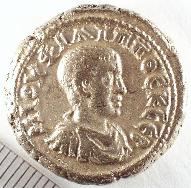
|
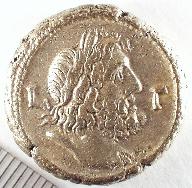
|
archive also available
| Chicago Coin Club | |
|---|---|
| Volume 51 No. 3 | March 2005 |
The 1034th meeting of the Chicago Coin Club was called to order at 7:00 PM by President Robert Feiler with 16 members present. The January minutes as published in the Chatter were approved. A motion was made and passed to approve Treasurer Steven Zitowsky’s January report of $296.00 in revenue and $154.79 in expenses. After Winston Zack’s application for junior membership received a second reading a motion was made and passed that he be accepted into the Club.
Carl Wolf gave a brief description on upcoming featured speakers prior to First V.P. Jeff Rosinia’s introduction of Mark Wieclaw, the meeting’s featured speaker. Mark spoke on The Tetradrachms of Roman Egypt, showed a number of fine numismatic specimens, and showed several major references. After answering several questions, Jeff presented Mark with an engraved Club speaker’s medal and an ANA Speaker Certificate.
Exhibitors for the evening were:
Under old business Jeff Rosinia and Carl Wolf reported no development on meeting sites that would reduce rental expense. Steve Huber volunteered to investigate purchasing audio visual equipment for exclusive club use to reduce rental expense. Jeff Rosinia reported that a subject had not been chosen for the Chicago Paper Money Expo souvenir card. Robert Leonard reported that the Togo stones had arrived for the Chicago International Coin Fair souvenir card and he would soon begin writing the article.
Under new business Treasurer Zitowsky reminded everyone to pay their 2005 dues. President Feiler delivered a short State of the Club Speech and asked everyone to bring at least one new member to the Club during 2005. Dr. Saul Needleman announced that he had submitted a proposal to the Board of Directors to issue another book as a fund raising project. Carl Wolf reported the ANA Convention Director Brenda Bishop visited Chicago last week and discussed the possibility of Chicago hosting the 2009 convention. A motion made by Robert Leonard to donate $50.00 to the American Numismatic Society’s Francis D. Campbell Library Chair in memory of those members who passed away in 2004. The motion passed.
Don Dool who provided audio visual equipment to view material on the television announced he would be in Argentina during the March meeting and the Club would have to make other arrangements.
The meeting was adjourned at 9:37 PM.
Respectfully submitted, Carl Wolf
Secretary
Presented by Mark Wieclaw to our February 9, 2005 meeting.
Over 500 locations are known to have issued Roman Provincial coinage, but only three cities, Caesarea in Capodocia, Antioch, and Alexandria, were located near a source of silver. While silver coins are known from many mints, these three cities were the steadiest issuers of silver Provincial coins.
Alexandria was the major city of Egypt when the Roman Emperor Augustus defeated Cleopatra and took Egypt as his personal property. All Egyptian exports also were the property of the Roman emperor; since the Nile valley was the major source of wheat for the entire Mediterranean area, Egypt provided a nice income to many emperors before control was yielded to the government.
The onset of Roman rule saw an increase in the silver in the Alexandrian coins. The severely debased tetradrachms (only 3-5% silver) of Cleopatra were replaced with the 30% silver coinage of Augustus. The Alexandrian silver coins were debased at about the same rate as the coins back in Rome: to about 25% fine under Claudius, down to the 6% silver consistency of billon under Tiberius who issued the the first Roman Alexandrian tetradrachms, and finally down to 1% for the last tetradrachms under Diocletian. It is believed that from Tiberius to Nero, one denarius was melted down and mixed with copper to obtain the metal needed for one tetradrachm.
The typical design showed the emperor on the obverse; very few women appeared on their own coins. One was Julia Mamea, the mother of Septimus Severus, and another was Severina who was in charge for a period after the murder of her husband Aurelian.
An eagle is the most commonly found reverse of a Roman Alexandrian tetradrachm. Among the other reverses Mark showed were a galley under sail, Zeus, and some other deities. This tetradrachm of Phillip II, 244-249AD, shows Zeus on the reverse.

|

|
In addition to the gradual quality decline over time, Mark showed coins demonstrating the decline during a single emperor. (And then the following emperor would start by issueing a coinage which, although better than the recent coinage of the previous emperor, was not always as good as the earliest coinage of the previous emperor.) Two coins of Philip II, from regnal years 3 and 6, show the nearly the same obverse and reverse devices, but the later coin's darker color is an obvious indication of its lower silver content.
The regnal years were identified with a combination of Egyptian and Greek symbols, instead of Roman numerals. Consider the characters LIB indicating the twelfth year of a reign: the L is the Egyption heiroglyphic for "year," while the Greek letters I and B represent ten and two, respectively.
Mark showed a coin of Gallienus with rough edges, but it is one of the last of the large-sized pieces.
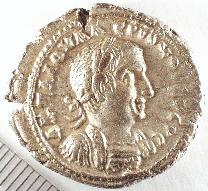
|
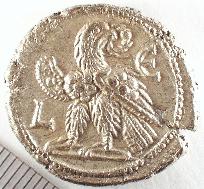
|
There are several reference books on the subject. The most definitive study is by Dattari, published in 1901, with reprints occasionally available. The text is in Italian and only a small percentage of varieties are pictured. In 1999, a limited run of hardbound copies were printed of the pencil rubbings of the entire Dattari collection.
A new reference by J.G. Milne was written in 1927, correcting some of the errors that appeared in Dattari. The text is in English and has been reprinted several times. More recently (1954) James W. Curtis authored a book that updated the works of both Dattari and Milne. A 1990 reprint also includes several auction and mail bid sales of Roman Egypt coins so that collectors may see what value these coins have achieved.
Each image has a scale in the lower-left corner, with the tics spaced 1 mm apart. Because the brightness and contrast were manipulated on a computer, the coloring of a coin's image differs from the coin's actual coloring.
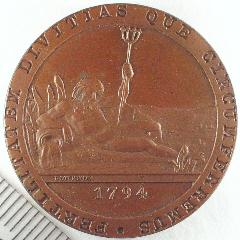
|
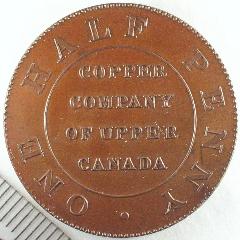
|
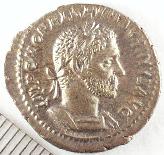
|
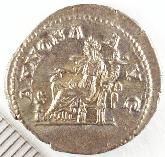
|
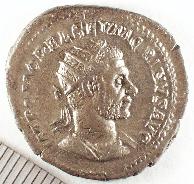
|
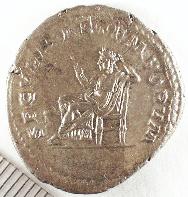
|
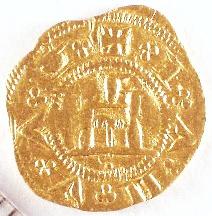
|
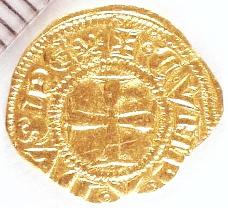
|
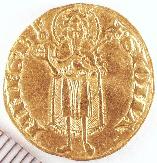
|
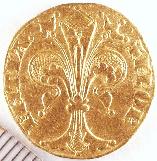
|
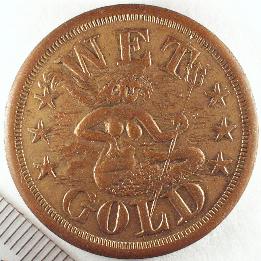
|
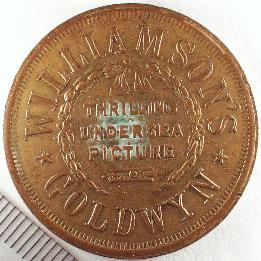
|
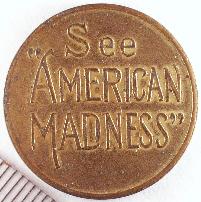
|
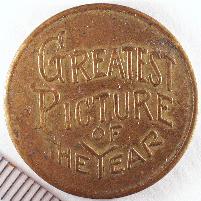
|
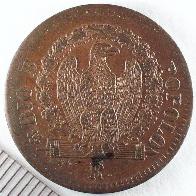
|
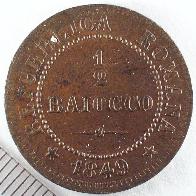
|
| Date: | March 9, 2005, First session |
| Time: | 7:00 PM |
| Location: | Downtown Chicago
At the Chicago Bar Association (CBA), 321 S. Plymouth Court, in the Albert F. Holfeld Room on the 5th floor. Please remember the security measures at our meeting building: everyone must show their photo-ID at the security desk. |
| Featured speaker: | Douglass F. Rohrman - Exciting Changes at the American Numismatic Society |
|
The American Numismatic Society (ANS) was organized in 1858 in New York City and has evolved into a preeminent national institution advancing the study of numismatics. Recently, the ANS moved to 96 Fulton Street in Lower Manhattan. The 35,000 square foot former bank building encompasses the world’s largest numismatic library (100,000 volumes) located on two full floors and a numismatic collection estimated at 800,000 pieces. Admission is free and the library and coin cabinet are open for research by appointment. Chicago attorney Douglass Rohrman sits on the Board of Trustees, the ANS governing body. Attend this presentation and hear about the new plans and programs on the ANS agenda. | |
| Date: | March 19, 2005 Second session |
| Time: | 1:00 PM |
| Location: | At the Chicago Paper Money Expo (CPMX), which is held at the Holiday Inn O'Hare, 5440 North River Road, Rosemont, IL. No admission charge for our meeting. |
| Featured speaker: | Mark Anderson - Hard Times in a Small Town Bank |
|
The First National Bank of Grantsburg, Wisconsin was founded in 1905 by Swedish immigrant H.A. Anderson, Mark's grandfather. Join this presentation and hear the story of this bank, its relationship with Wisconsin’s agrarian economy and Anderson's struggle to survive hard times and persevere with competing banks. Mark's presentation will show rare numismatic souvenirs and family photos. Collectors attending this program will come away with a perspective and appreciation that every bank note has a unique history and a story with real people. |
| March | 9 | CCC Meeting - Featured Speaker - Douglass F. Rohrman on Exciting Changes at the American Numismatic Society |
| March | 18-20 | 11th Annual Chicago Paper Money Expo (CPMX) at the Holiday Inn O'Hare, 5440 North River Road, Rosemont. Admission is $5 for Friday and Saturday; free on Sunday. |
| March | 19 | CCC Meeting - 1pm at the Chicago Paper Money Exposition,
which is held at the Holiday Inn O'Hare, 5440 N. River Road, Rosemont, IL.
No admission charge for our meeting.
Featured Speaker - Mark Anderson on Hard Times in a Small Town Bank |
| April | 13 | CCC Meeting - Featured Speaker - Alex Molinas on Coin Grading Perspectives |
| April | 22-24 | 30th Annual Chicago International Coin Fair (CICF) at the Holiday Inn O'Hare, 5440 North River Road, Rosemont. Admission is $5 for Friday and Saturday; free on Sunday. |
| April | 23 | CCC Meeting - 1pm at the Chicago International Coin Fair (CICF),
which is held at the Holiday Inn O'Hare, 5440 North River Road, Rosemont, IL.
No admission charge for our meeting.
Featured Speaker - to be announced |
| May | 11 | CCC Meeting - Featured Speaker - to be announced |
| April | 1 | Charles J. Ryant, Jr. | |
| April | 12 | Mark Wieclaw | 1991 |
| April | 15 | Robert D. Leonard, Jr. | 1983 |
| April | 15 | Charles Menard | 1995 |
| April | 27 | Don Valenziano | 1982 |
All correspondence pertaining to Club matters
should be addressed to the Secretary and mailed to:
CHICAGO COIN CLUB
P.O. Box 2301
CHICAGO, IL 60690
http://www.ChicagoCoinClub.org/
prhybert@worldnet.att.net
| Robert Feiler | - President |
| Jeff Rosinia | - First Vice President |
| Lyle Daly | - Second Vice President |
| Directors: | Phil Carrigan
Carl Wolf Steve Zitowsky Mark Wieclaw |
| Other positions held are: | |
| Bill Burd/Carl Wolf | - Secretary |
| Steve Zitowsky | - Treasurer |
| Paul Hybert | - Chatter Editor |
| William Burd | - Archivist |